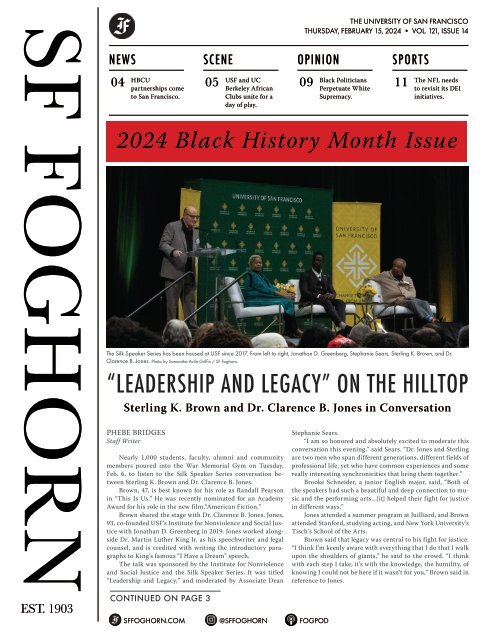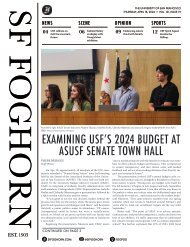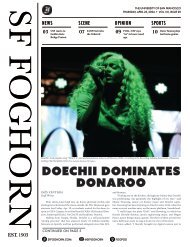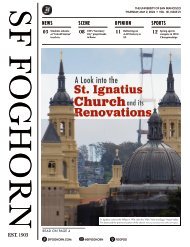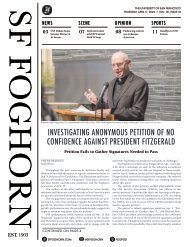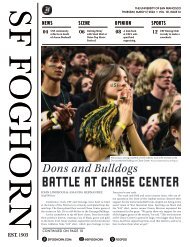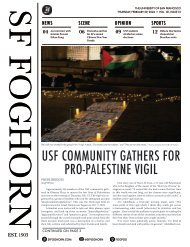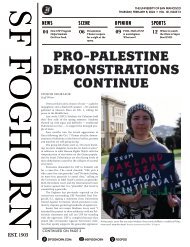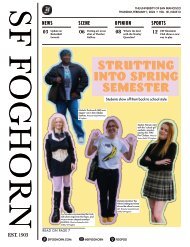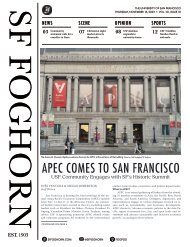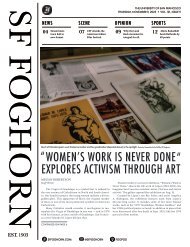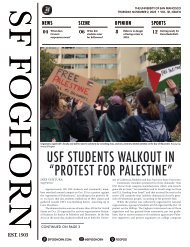FOGHORN ISSUE 14 FINAL
You also want an ePaper? Increase the reach of your titles
YUMPU automatically turns print PDFs into web optimized ePapers that Google loves.
SF <strong>FOGHORN</strong><br />
EST. 1903<br />
NEWS<br />
04<br />
HBCU<br />
partnerships come<br />
to San Francisco.<br />
PHEBE BRIDGES<br />
Staff Writer<br />
Nearly 1,000 students, faculty, alumni and community<br />
members poured into the War Memorial Gym on Tuesday,<br />
Feb. 6, to listen to the Silk Speaker Series conversation between<br />
Sterling K. Brown and Dr. Clarence B. Jones.<br />
Brown, 47, is best known for his role as Randall Pearson<br />
in “This Is Us.” He was recently nominated for an Academy<br />
Award for his role in the new film,“American Fiction.”<br />
Brown shared the stage with Dr. Clarence B. Jones. Jones,<br />
93, co-founded USF’s Institute for Nonviolence and Social Justice<br />
with Jonathan D. Greenberg in 2019. Jones worked alongside<br />
Dr. Martin Luther King Jr. as his speechwriter and legal<br />
counsel, and is credited with writing the introductory paragraphs<br />
to King’s famous “I Have a Dream” speech.<br />
The talk was sponsored by the Institute for Nonviolence<br />
and Social Justice and the Silk Speaker Series. It was titled<br />
“Leadership and Legacy,” and moderated by Associate Dean<br />
CONTINUED ON PAGE 3<br />
SF<strong>FOGHORN</strong>.COM<br />
SCENE<br />
05<br />
USF and UC<br />
Berkeley African<br />
Clubs unite for a<br />
day of play.<br />
@SF<strong>FOGHORN</strong><br />
THE UNIVERSITY OF SAN FRANCISCO<br />
THURSDAY, FEBRUARY 15, 2024 • VOL. 121, <strong>ISSUE</strong> <strong>14</strong><br />
OPINION<br />
09<br />
Stephanie Sears.<br />
“I am so honored and absolutely excited to moderate this<br />
conversation this evening,” said Sears. “Dr. Jones and Sterling<br />
are two men who span different generations, different fields of<br />
professional life, yet who have common experiences and some<br />
really interesting synchronicities that bring them together.”<br />
Brooke Schneider, a junior English major, said, “Both of<br />
the speakers had such a beautiful and deep connection to music<br />
and the performing arts…[it] helped their fight for justice<br />
in different ways.”<br />
Jones attended a summer program at Juilliard, and Brown<br />
attended Stanford, studying acting, and New York University’s<br />
Tisch’s School of the Arts.<br />
Brown said that legacy was central to his fight for justice.<br />
“I think I’m keenly aware with everything that I do that I walk<br />
upon the shoulders of giants,” he said to the crowd. “I think<br />
with each step I take, it’s with the knowledge, the humility, of<br />
knowing I could not be here if it wasn’t for you,” Brown said in<br />
reference to Jones.<br />
FOGPOD<br />
Black Politicians<br />
Perpetuate White<br />
Supremacy.<br />
SPORTS<br />
11<br />
The NFL needs<br />
to revisit its DEI<br />
initiatives.<br />
2024 Black History Month Issue<br />
The Silk Speaker Series has been housed at USF since 2017. From left to right, Jonathan D. Greenberg, Stephanie Sears, Sterling K. Brown, and Dr.<br />
Clarence B. Jones. Photo by Samantha Avila Griffin / SF Foghorn.<br />
“LEADERSHIP AND LEGACY” ON THE HILLTOP<br />
Sterling K. Brown and Dr. Clarence B. Jones in Conversation
02 03<br />
THURSDAY<br />
FEB. 15<br />
2024<br />
STAFF<br />
Editor in Chief<br />
MEGAN ROBERTSON<br />
mrrobertson2@dons.usfca.edu<br />
News Editor<br />
NIKI SEDAGHAT<br />
nisedaghat@dons.usfca.edu<br />
Opinion Editor<br />
CHISOM OKORAFOR<br />
cokorafor@dons.usfca.edu<br />
Scene Editor<br />
INÉS VENTURA<br />
ipventura@dons.usfca.edu<br />
Sports Editor<br />
CHASE DARDEN<br />
cbdarden@dons.usfca.edu<br />
Photography Editor<br />
SAMANTHA AVILA GRIFFIN<br />
svavilagriffin@dons.usfca.edu<br />
General Reporter<br />
PHEBE BRIDGES<br />
pjbridges@dons.usfca.edu<br />
General Reporter<br />
ELINA GRAHAM<br />
emgraham@dons.usfca.edu<br />
415.422.5444<br />
sffoghorn.com<br />
SUBMISSION POLICY<br />
The San Francisco Foghorn is the<br />
official student newspaper of the<br />
University of San Francisco and<br />
is sponsored by the Associated<br />
Students of the University of San<br />
Francisco (ASUSF).<br />
The thoughts and opinions<br />
expressed herein are those of the<br />
individual writers and do not<br />
necessarily reflect those of the<br />
Foghorn staff, the administration,<br />
the faculty, staff or the students of<br />
the University of San Francisco.<br />
Contents of each issue are the sole<br />
responsibilities of the editors.<br />
An All-American<br />
Publication<br />
ad maiorem dei<br />
gloriam<br />
The San Francisco Foghorn is free<br />
of charge.<br />
Advertising matter printed herein<br />
is solely for informational purposes.<br />
Such printing is not to be construed<br />
as written or implied sponsorship<br />
or endorsement of such commercial<br />
enterprises or ventures by the San<br />
Francisco Foghorn.<br />
©MMIV-MMV, San Francisco<br />
Foghorn. All rights reserved. No<br />
material printed herein may be reproduced<br />
without prior permission<br />
of the Editor in Chief.<br />
SAN FRANCISCO<br />
<strong>FOGHORN</strong><br />
Freedom and Fairness<br />
Managing Editor<br />
JORDAN PREMMER<br />
jepremmer@dons.usfca.edu<br />
Copy Editor<br />
SOPHIA SIEGEL<br />
scsiegel@dons.usfca.edu<br />
Layout Editor<br />
ANYA JORDAN<br />
arjordan@dons.usfca.edu<br />
Layout Editor<br />
HALLEY COMPUTESTO<br />
hmcompuesto@dons.usfca.edu<br />
Social Media Manager<br />
MARIA ZAIED<br />
mfzaied@dons.usfca.edu<br />
Online Editor<br />
ESHA DUPUGUNTLA<br />
ekdupuguntla@dons.usfca.edu<br />
ADVISOR<br />
TERESA MOORE<br />
2130 FULTON STREET, UC #417<br />
SAN FRANCISCO, CA 94117<br />
Columns for the Opinion section<br />
and Letters to the Editor are gladly<br />
accepted from students, faculty, staff<br />
and alumni.<br />
All materials must be signed and<br />
include your printed name, university<br />
status (class standing or title),<br />
address, and telephone number for<br />
verification. Anonymous submissions<br />
are not published.<br />
We reserve the right to edit materials<br />
submitted. All submissions<br />
become the property of the San<br />
Francisco Foghorn.<br />
Staff editorials are written by the<br />
Foghorn editorial staff and represent<br />
a group consensus.<br />
The San Francisco Foghorn Opinion<br />
page is a forum for the free, fair and<br />
civil exchange of ideas. Contributors’<br />
opinions are not meant to<br />
reflect the views of the Foghorn staff<br />
or the University of San Francisco.<br />
Students interested in contributing<br />
to the Foghorn can scan and fill out<br />
the QR code below.<br />
STAFF EDITORIAL<br />
BLACADEMIA<br />
USF’s Solution to the Black Education Gap<br />
USF has been a frontrunner in<br />
extending education to Black people.<br />
Since the 1950s, Black students such<br />
as Bill Russell have left their legacies<br />
on the Hilltop, and Black activism<br />
has been a campus staple since the<br />
‘60s, with the formation of the USF<br />
Black Student Union.<br />
However, despite decades of<br />
progress towards equalizing access to<br />
education around the United States,<br />
it is critical to acknowledge that education<br />
remains a struggle for Black<br />
Americans. More needs to be done to<br />
bridge existing racial education gaps,<br />
and USF provides a roadmap for how<br />
to do it.<br />
Less than 200 years ago, anti-literacy<br />
laws prohibited Black people<br />
from reading and writing. It wasn’t<br />
until 1867 that these laws were lifted,<br />
but even then, education wasn’t<br />
an equal right for Black Americans.<br />
For decades, schools were legally segregated<br />
between white and non-white<br />
students, with non-white students<br />
getting the short end of the stick. Although<br />
this history may seem distant,<br />
Ruby Bridges, the first Black child<br />
to integrate into an all-white public<br />
school in 1960, is only 69-years-old<br />
today, younger than both Donald<br />
Trump and President Joe Biden.<br />
The legacy of Black exclusion<br />
from academia is still alive, too. The<br />
U.S. public school system remains<br />
highly racially segregated. Majority<br />
Black school districts consistently receive<br />
less funding than their majority<br />
white counterparts. Black students in<br />
these underfunded areas do not always<br />
have equal access to academic<br />
support like college preparatory resources<br />
and tutoring.<br />
In addition to this, Black students<br />
are taught and disciplined differently<br />
than their non-Black classmates due<br />
to pre-existing racial biases held by<br />
teachers and administrators. According<br />
to the American Psychological<br />
Association, Black students are more<br />
likely to be punished with suspension<br />
and expulsion, less likely to be in gifted<br />
programs, and met with lower expectations<br />
from their teachers.<br />
These problems don’t disappear<br />
after high school. Black students face<br />
many barriers in the college environment,<br />
leading to nearly half of all<br />
Black students contemplating dropping<br />
out. In the 2010s, Black college<br />
enrollment declined by a whopping<br />
22% nationwide.<br />
Barriers such as high tuition<br />
costs, food access and housing complications<br />
hit Black students especially<br />
hard. Discrimination faced in<br />
colleges only adds to their stress.<br />
To help alleviate this, universities<br />
should strive towards creating<br />
a more welcoming environment for<br />
Black students. USF’s Black Achievement<br />
Sucess and Engagement (BASE)<br />
Initiative provides a good framework<br />
for how universities around the nation<br />
should support their Black students.<br />
BASE has many resources to<br />
help Black students flourish, such<br />
as scholarships, the Black Resource<br />
Center and the Marshall-Riley Living<br />
Learning Community, among others.<br />
It’s working. According to their<br />
website, USF’s graduation rate for<br />
Black-identified students is 71.4%, in<br />
comparison to the national average of<br />
just 40%. The program boasts a nearly<br />
20% increase in Black students in<br />
only two years. Through BASE, USF<br />
has created a successful model to<br />
support Black students. Other universities<br />
should follow suit.<br />
Education can be a welcoming<br />
space for Black people. Educational<br />
institutions just need to invest in cultivating<br />
it.<br />
Editor’s Note: Foghorn Opinion<br />
Editor Chisom Okorafor is a member<br />
of BASE’s Black Scholars Scholarship<br />
Program.<br />
The Marshall Riley Living Learning Community on a historical field trip. Photo from @baseusfca<br />
on Instagram.<br />
CONTINUED FROM FRONT PAGE<br />
Chase Darden (left) told Sterling K. Brown (right), “my dad said [you’re] the next<br />
Denzel Washington.” Photo by Samantha Avila Griffin / SF Foghorn.<br />
“You’re talking about Paul Robeson, and Lorraine Hansberry, and<br />
James Baldwin, and Sidney Poitier, and Harry Belafonte, etcetera. I<br />
could not be here if these individuals had not forged the path for it to<br />
be easier for me. I have a responsibility to make it a little bit easier for<br />
anybody that comes after me.”<br />
Aniya Williams, a sophomore media studies major, said she enjoyed<br />
“[seeing] how Dr. Clarence came to be and his motivations behind<br />
his activism, and also knowing that he inspires Sterling K. Brown,<br />
who is of an entirely different generation.”<br />
Williams was one of approximately 20 students who attended a<br />
small, pre-event Q&A session at Lone Mountain’s Studio Theater with<br />
Brown and Rev. Dr. Ronné Wingate Sims.<br />
Sims is an ordained Baptist minister and member of the University<br />
Ministry staff. She moderated the Q&A session with Brown, focusing<br />
on what it’s like to be a Black man working in the entertainment<br />
industry. After their discussion, students asked Brown questions.<br />
“[Brown] coming to sit with me and my friends, who are also of a<br />
different generation, shows how we have to have this callback to past<br />
generations and take in what they say,” Williams said.<br />
Foghorn Sports Editor Chase Darden was particularly keen to<br />
meet Brown at this event, being that. Brown’s first-Emmy win in 2016<br />
was for playing the editor’s father, Christopher Darden, in “The People<br />
V. O.J. Simpson: American Crime Story.”<br />
“It was funny because when I told him who I was, he looked at me<br />
as if he saw a ghost,” Chase Darden said.<br />
During the central talk, the two men spoke about their experiences<br />
with education. Jones said, “As a result of the education I got from<br />
those Irish Catholic nuns, ages 6 to <strong>14</strong>, I am, have been, committed to<br />
the pursuit of excellence… the pursuit of knowledge.”<br />
Brown spoke to his own experience in university. “It gave me confidence,<br />
in terms of what I wanted to do. I knew I had talent… I wanted<br />
to have a set of skills I could take from role to role.”<br />
In the talk, Jones reflected on his friendships with Jewish students<br />
while attending Columbia University, their relationship strengthened<br />
by discrimination both of their communities faced. While sharing anecdotes<br />
about the discrimination both groups endured, Jones repeatedly<br />
used a slur historically used against Jewish people.<br />
In the following days, a commercial starring Jones aired during<br />
the Super Bowl by the Foundation to Combat Antisemitism. According<br />
to CBS News, the 30-second ad cost approximately $7 million dollars.<br />
The Foghorn requested a comment, about the phrase and advertisement,<br />
from Jonathan D. Greenberg, co-founder of the Institute for<br />
Nonviolence and Social Justice. Greenberg acknowledged the request<br />
but did not reply in time for print. Should the Foghorn receive a comment,<br />
you will find an updated version of this article on our website.<br />
Jones’ last piece of advice for students was to “read, read, read,<br />
read, read.” This stuck out to sophomore sociology major Mecedes<br />
Lindsay. “I think [picking] up physical media is a lost art… I’m excited<br />
to hear what stories and interactions [Jones] had with some of the<br />
people I look up to.”<br />
Board of Trustees member Adam Swig told the Foghorn that the<br />
Silk Series “is an opportunity to hear from some of the greatest voices<br />
out there. Dr. Jones is an American treasure. He’s living history. He is<br />
the record of truth, and we all need to listen to the truth-speakers.”<br />
Editor-in-Chief: Megan Robertson, Chief Copy Editor: Sophia Siegel,<br />
Managing Editor: Jordan Premmer, News Editor: Niki Sedaghat<br />
Performing Arts and Social Justice students were given priority to reserve tickets for the pre-event Q&A conversation with Rev. Dr. Ronné Wingate Sims (left) and Sterling K.<br />
Brown (right). Photo by Samantha Avila Griffin / SF Foghorn.<br />
NEWS
04 05<br />
THURSDAY<br />
FEB. 15<br />
2024<br />
NEWS<br />
HBCUS MAKE WAY TO DOWNTOWN SF<br />
NIKI SEDAGHAT<br />
Staff Writer<br />
Historically Black College and Universities<br />
(HBCUs) partnerships are coming<br />
to San Francisco this summer. At their<br />
third annual conference, “Dreaming Forward:<br />
Black to San Francisco,” on Feb. 1,<br />
The City’s Dream Keeper Initiative invited<br />
the public to engage with City officials<br />
and stakeholders on accomplishments and<br />
hopes for future projects.<br />
Partnerships with HBCUs were at the<br />
forefront of these conversations. These initiatives,<br />
which would begin this summer,<br />
have the support of Mayor London Breed.<br />
“Black 2 San Francisco” is one such<br />
initiative led by the Human Rights Commission.<br />
It is piloting a program where<br />
major HBCUs around the nation will have<br />
programs Downtown during the summer<br />
months. While the universities have yet<br />
to be confirmed, possible partner schools<br />
include: Howard University, Morehouse<br />
College, and Tuskegee University, among<br />
others.<br />
The long-term goal of these partnerships<br />
is to establish permanent San Francisco<br />
HBCU satellite campuses, according to SF Govs. Feb. 2 press<br />
release.<br />
HBCUs are institutions created from 1837 to 1964 in the era of<br />
legal segregation, with the intention of providing higher education<br />
access to Black Americans, according to the National Center for Education<br />
Statistics. There are now more than 100 HBCUs across the<br />
United States, and while they remain predominantly Black, students<br />
of all races are able to enroll.<br />
University of San Francisco, along with other Bay Area universities<br />
will support the initiative. USF will offer housing, San Francisco<br />
State University will provide classrooms, and the University of<br />
California, San Francisco will provide an array of support services to<br />
students.<br />
“It takes a village to help people, and historically black colleges<br />
and universities have historically not gotten the support that they<br />
needed or that they deserve, have not gotten the help required to run<br />
at maximum efficiency,” said Maxwell Edmonds-Drati, junior politics<br />
major.<br />
On Sept. 18, 2023, U.S. Secretary of Education Miguel Cardona<br />
and U.S. Secretary of Agriculture Thomas Vilsack sent letters to 16<br />
governors that revealed a $12 billion disparity in funding between<br />
HBCUs and non-HBCUs.<br />
“Unacceptable funding inequities have forced many of our nation’s<br />
distinguished Historically Black Colleges and Universities to<br />
operate with inadequate resources and delay critical investments in<br />
everything from campus infrastructure to research and development<br />
to student support services,” stated Cardona in the letter.<br />
San Francisco taking the initiative to support HBCUs has been<br />
received well by many USF students. Edmonds-Drati, who is also the<br />
Community Outreach Liaison for USF’s Brother Connection, said, “I<br />
actually think it’s a really smart move. And I think it’s something that<br />
we need to do…because it would bring diversification to the city of San<br />
Francisco which has lost a significant amount of Black people.”<br />
According to CalMatters, there has been a 43% decrease of the<br />
Black population in San Francisco from 1990-2018. This mass urban<br />
exodus comes at the result of rising costs, leading to disproportionate<br />
rates of eviction.<br />
The San Francisco Human Rights Commission strives towards “racial solidarity, equity, and healing” by working on<br />
city anti-discrimination laws, according to their webpage. Photo from @Bayviewmagic on Instagram<br />
In an effort to incorporate academics in revitalization efforts of<br />
Downtown and the overall economy, City leaders and institutions believe<br />
this program will be a step towards filling vacancies in Downtown.<br />
“By bringing HBCUs to our City, we can not only create a connection<br />
to empower our next generation of leaders, but we can also<br />
contribute to the revitalization of our City,” said Breed in a Feb. 2<br />
statement.<br />
Also included in the Feb. 1 conference discussions were: the City<br />
Attorney’s Office, Department of Environment, San Francisco Unified<br />
School District, Office of Economic Workforce and Development, and<br />
the Department of Police Accountability.<br />
“After many years of planning, and months of seeding and working<br />
to create meaningful partnerships, all the stakeholders are together<br />
to explore how we can connect San Francisco to the incredible talent<br />
that has historically been cultivated and supported by HBCUs,”<br />
said Executive Director of San Francisco Human Rights Commission,<br />
Dr. Sheryl Davis, in the same statement.<br />
“Our local higher education partners have been actively involved<br />
and are central to this project. These efforts have been a long time<br />
coming from both community conversations to design the Dream<br />
Keeper Initiative and recommendations from the Reparations Advisory<br />
committee. I am heartened to see where the work goes from here,”<br />
Davis continued.<br />
The African American Reparations Advisory Committee is an advisory<br />
group for the board of supervisors, the mayor, and the Human<br />
Rights Commission to create a Reparations Plan to address inequalities<br />
in the City.<br />
“I feel like we don’t really have a space for us, in society unless we<br />
create spaces that we had to fight to get created. So I think HBCUs<br />
offer this really unique place where we can just be ourselves and enjoy<br />
our culture,” Edmonds-Drati said.<br />
The Foghorn will continue to report on updates to USF’s involvement<br />
with this initiative.<br />
Editor-in-Chief: Megan Robertson, Chief Copy Editor: Sophia Siegel,<br />
Managing Editor: Jordan Premmer, News Editor: Niki Sedaghat<br />
CREATING A “VILLAGE OF LOVE AND<br />
JOY” AT ASA’S FIELD DAY<br />
ELINA GRAHAM<br />
Staff Writer<br />
USF and UC Berkeley Unite from Across the Bay for a Field Day<br />
Surrounded by pickup ball games and enthusiastic children in the<br />
Fillmore’s communal James P. Lang Athletic Field, members of USF’s<br />
African Student Association (ASA) played games and enjoyed the sun<br />
during their Field Day event on Feb. 10. Planned in partnership with<br />
the University of California, Berkeley’s Nigerian Student Association<br />
(NSA), this event marked ASA’s first collaboration with an organization<br />
from outside of USF. The goal of the event was to unite two Bay<br />
Area African culture clubs and find a unique way to honor Black History<br />
Month.<br />
“We really wanted to bridge the gap between Black students and<br />
African students on campus,” ASA President DaAujana Florence said.<br />
“Though we may have different ethnic and cultural identities, we are<br />
all Black students, so it’s important that we support one another in our<br />
mission to create safe spaces for Black faces and voices.”<br />
Co-hosting with UC Berkeley’s NSA was important to Florence.<br />
“We also wanted to let other Black organizations at other universities<br />
such as Berkeley know that we see them and we appreciate<br />
them,” she said.<br />
Attendees enjoyed pizza and games, including tug of war,<br />
giant Jenga and soccer, under the clear blue sky. All activities<br />
were teamwork based, promoting collaboration and friendly<br />
competition, as well as encouraging players to get out of their<br />
comfort zones. “My favorite part of the event was creating<br />
fellowship with other students on campus,” said USF senior<br />
advertising major Dominic Jaikaran.<br />
Florence hopes to see more intentionality in the celebration<br />
of Black students on campus, as well as an increase in<br />
diverse connectedness across the Bay. “When thinking about<br />
the Bay Area, all of the possibilities can be a little intimidating<br />
at times,” said Florence. “However, I think that the way we<br />
have started in building a strong bond within our own community<br />
first, and now branching out and welcoming others into our<br />
community, is the best way that we see to continue to move towards<br />
inclusivity and mass representation.”<br />
USF junior biology major Matty Mboweni said, “I thought it was a<br />
lot of fun!” Mboweni, who is also ASA’s events coordinator, said, “We<br />
were able to play soccer games and some dodgeball games as well…<br />
It was just nice after a long stressful week to just hang out with some<br />
friends.”<br />
Florence said, “We wanted to allow our members to celebrate<br />
their Blackness in a unique way, and we thought the best way to do<br />
that was to intentionally share space with other African students in an<br />
effort to create our own little village of love and joy.”<br />
ASA has more events planned for the semester, including a screening<br />
of the Nigerian and Congolese love story, “The Wedding Party,” on<br />
May 5. Tickets will be available soon and more information can be<br />
found on the club’s Instagram page, @asaofusf.<br />
Editor-in-Chief: Megan Robertson, Chief Copy Editor: Sophia Siegel,<br />
Managing Editor: Jordan Premmer, Scene Editor: Inés Ventura<br />
While not a typical field day activity, Dominic Jaikaran (left) and Michael Ossie<br />
(right) are focused on their game of giant jenga. Photo by Veston Smith/ SF <strong>FOGHORN</strong><br />
The African Student Association was established on USF’s campus in 2018. Photo by<br />
Veston Smith / SF <strong>FOGHORN</strong><br />
SCENE
06 07<br />
THURSDAY<br />
FEB. 15<br />
2024<br />
A FOODIE’S<br />
ROADMAP TO THE<br />
TENDERLOIN<br />
delicious vegan options, Golden Era Vegan Restaurant serves blends of<br />
Aulacese (Vietnamese), Chinese, Indian, and Thai cuisine under the<br />
ethos of a plant based diet. Right across the street from them is Gateway<br />
Croissant, home of doughnuts as golden as the avenue it lives on,<br />
with pastries ranging from simple muffins to delectable churros. The<br />
owner serves each individual with humility and neighborly familiarity.<br />
Hidden under scaffolding, Spice of India could easily be missed,<br />
but certainly should not be. If you’re craving spicy samosas or a refreshingly<br />
tangy drink like the recommended mango lassi — which<br />
owner Madina A. claims is so good she “could have it in an IV drip to<br />
[her] soul” — this is the place to be. Beyond savoring the comfort of<br />
her food, it was a joy to hear Madina fawn over the process of cooking.<br />
A small family and women-owned business, Madina offers a familiarity<br />
and friendliness akin to the other Tenderloin haunts. Something<br />
about hearing her describe the balance of flavor notes and ingredients<br />
in her mango lassi gives a deeper glance into how much more these<br />
places are than a quick bite.<br />
Food just scratches the surface of the impact immigrant families<br />
have had on the Tenderloin community. Had I not heard Leah describe<br />
the area’s rich history, I might not have found these four delicious<br />
manifestations of that rich cultural blend that lives there. In Laxamana’s<br />
words, “the ongoing work is to peel away the counter narrative…<br />
what are you gonna do instead of talking about it?”<br />
Editor-in-Chief: Megan Robertson, Chief Copy Editor: Sophia Siegel,<br />
Managing Editor: Jordan Premmer, Scene Editor: Inés Ventura<br />
A Resident’s Recommendations<br />
for Cuisine & Counternarratives<br />
The Faithful Fools hosts “street retreats” several times a year for community members to spend time<br />
connecting with each other and the neighborhood. For more info, visit faithfulfools.org.<br />
Photo by Samantha Avila Griffin/ SF <strong>FOGHORN</strong><br />
SCENE<br />
REMI BRANDLI<br />
Contributing Writer<br />
GATEWAY CROISSANTS<br />
390 Golden Gate Ave<br />
Open 24/7<br />
I’ve often heard the Tenderloin contextualized as the butt of<br />
a joke, a catalyst of horror stories and generally a place to avoid.<br />
Yet, according to SFPD statistics, the Tenderloin in 2023 was the<br />
location of less than 1% of crimes in the city, only a recorded<br />
2,847 out of 50,529 total. There has also been a 10.1% decrease<br />
in crime in the Tenderloin, while crime in the Richmond district<br />
increased 1.3% in the past year.<br />
To see for myself, I went to the Tenderloin and spoke with<br />
The Faithful Fools to learn more about the neighborhood’s rich<br />
blends of culture.<br />
The Fools are among many nonprofits that provide services<br />
such as arts and education programs, essential worker support<br />
and survival resources for residents. Founded in 1998 by Kay Jorgensen<br />
and Carmen Barsody, the Fools have built their legacy<br />
around their ground-level exposure to the realities of poverty<br />
and life on the streets. I first was connected with the organization<br />
in the fall of 2022 through USF’s Honoring Our Queer<br />
Religious Elders class.<br />
Leah Laxamana, co-director of the Fools, is a longtime resident<br />
of the Tenderloin, referred to as the “TL.” Laxamana is<br />
aware of the harsh realities existing in the Tenderloin. “The reputation<br />
precedes itself,” she said. However, she said, “Crime and<br />
violence, they happen outside TL. There’s nothing special here<br />
that doesn’t happen anywhere else, what happens here is there’s<br />
no secrets — this is life unedited.”<br />
The essence of the Fools’ philosophy is based in gradually<br />
increasing meaningful interaction within the Tenderloin, or<br />
“finding different access points based on peoples comfortability,<br />
and then challenging that,” in Laxamana’s words.<br />
Referencing a Korean tapas restaurant around the block,<br />
Laxamana told me about the vast cultural blend of her neighborhood<br />
from the high volume of immigrant families. The Tenderloin<br />
is “a food haven,” Laxamana said. The best way to become<br />
acquainted with the neighborhood is to “eat your way through<br />
the TL,” she said. So, I ate.<br />
Around the corner from the Fools is Z Zoul Café, a Black<br />
family-owned, Sudanese restaurant.. The 6-year resident has a<br />
similar outlook on the neighborhood as the Fools. “It’s not all<br />
about Tenderloin — there is Tenderloin in each city in the world,”<br />
said owner Aref Elgaali. Elgaali has also been the co-founder and<br />
president of the Tenderloin Merchant and Property Owner’s Association<br />
(TMA) since 2019.<br />
One of the few Black-owned restaurants in the area, Z<br />
Zoul offers the cuisine of Sudan with a view of vibrant buildings<br />
surrounding the restaurant. Elgaali’s wisdom pairs well<br />
with the food — if you can trap him into a conversation while<br />
ordering, that is. Upon walking in, I was greeted with a warm<br />
aroma of cumin and garlic. For $12.75, you can enjoy Elgaali’s<br />
highly recommended Chicken Shawarma wrap, and chase it<br />
down with his reflections about the greater community. Egaali<br />
recalled, “if you came [during] APEC and you see the Tenderloin<br />
— it’s different. They cleaned it up.”<br />
Down a few blocks from Z Zoul and the Fools, Larkin<br />
street is stacked with restaurants rich in flavor, celebrating<br />
culture with a ‘service with a smile’ mentality. If you’re seeking<br />
After Proposition G was<br />
passed in 2007, chain<br />
stores found it difficult to<br />
open in the city, which is<br />
why you won’t see recognizable<br />
donut spots like<br />
Yum Yum Donuts or Krispy<br />
Kreme on the streets. Photo<br />
by Samantha Avila Griffin/<br />
SF <strong>FOGHORN</strong><br />
Wondering how to get to the Tenderloin? Hop on the 5 Muni line and ride for<br />
15 minutes (or 9 stops),hop off at McAllister and Leavenworth, and walk for<br />
about 9 minutes up Leavenworth towards O’Farrell St.<br />
SPICE OF INDIA<br />
The Elaagi family migrated to the U.S. in 2016, and opened the Z Zoul<br />
cafe after realizing that the city was missing an authentic Sudanese<br />
restaurant. Photo by Samantha Avila Griffin/ SF <strong>FOGHORN</strong><br />
The mural (to the right) shows an artist replica of the owner’s mother.<br />
Photo by Samantha Avila Griffin/ SF <strong>FOGHORN</strong><br />
GOLDEN ERA VEGAN<br />
RESTAURANT<br />
448 Larkin St 395 Golden Gate Ave<br />
10a.m. - 12 a.m. Sunday - Saturday<br />
Sunday - Saturday 11a.m.- 7:30 p.m.<br />
Z ZOUL CAFÉ<br />
295 Eddy St<br />
Monday-Friday 9:30 a.m. -<br />
7:30 p.m.<br />
Sunday 12 – 6:30 p.m.<br />
Saturday 12 – 7:30 p.m.<br />
SCENE
08 09<br />
THURSDAY<br />
FEB. 15<br />
2024<br />
BLACK FACES, WHITE SYSTEMS<br />
How Black People Can Uphold Oppressive Systems<br />
SCENE<br />
Daleyn Brown (shown above) was behind USF’s first Black student music showcase which will take place again this April. Photo by Kaleb Martinez/ SF <strong>FOGHORN</strong><br />
POETS POP-OFF AT LYRICIST LOUNGE<br />
INÉS VENTURA<br />
Staff Writer<br />
“Who’s voice is important to you?” It could be that of a friend,<br />
your mother, or the oppressed. For poets who took the mic at last<br />
week’s Lyricist Lounge on UC 4, it was all of the above.<br />
The Intercultural Center hosts monthly Lyricist Lounge nights,<br />
where students have the opportunity to take to the stage, show off<br />
their poetic material and tap into their artistic sides. This month’s<br />
rendition was in honor of Black History Month.<br />
The UC 4 lounge was transformed into a poet’s sanctuary with<br />
dimmed lighting and a makeshift stage — featuring a black curtain<br />
and paper made tree, which performers stood under as they recited<br />
their work. Titles of the night’s performances included “A Letter to my<br />
Future Daughter” and “A Village Called Perth.”<br />
Mikayla Bell, who performed “I’m Not a Love Poet,” is a fine<br />
arts major with a minor in African American studies, but outside of<br />
schoolwork she puts her pen to paper and creates poetry whenever inspiration<br />
strikes. “I really like open mics and the intensity of the small<br />
crowd, especially the callbacks — it’s nice to hear from the crowd.”<br />
Audience members showered performers with snaps after every<br />
act to show support. If a poet was giving new material, the audience<br />
would call “new shit,” or “old shit,” for material that wasn’t new to the<br />
performer’s ears, but was to others.<br />
On what inspired her not-a-love poem, Bell said, “It was not about<br />
the person, but just how I love, and showcasing that infatuation and<br />
carelessness.” She continued, “That’s why I think poetry is really cool,<br />
because you can document raw stages of your own mind in your own<br />
words. So like, at the time, I was really in love.”<br />
In his welcome speech at the opening of the event, Delayn Brown<br />
said, “The goal of tonight is to find our voices… especially Black<br />
voices.” Brown, a senior international business major and music minor,<br />
works in the Intercultural Center and organizes all the Lyricist<br />
Lounges of the school year.<br />
“I think it is very important that this is a student planned event,<br />
because of the possibility of collaborating with other organizations,<br />
and because students like to see other students, instead of a teacher,”<br />
Brown continued.<br />
Brown ended the intimate evening by leading the audience of<br />
around 20 people through a practice called Isaang Bagsak. The term,<br />
meaning “one down” in Tagalog, is the name of a practice adopted<br />
from anti-martial law activists in the Philippines. It starts with a community<br />
member clapping at a slow tempo, then more people join in<br />
as the pace picks up, until eventually all members of the community<br />
are clapping together in a loud, powerful unison that you could feel in<br />
your chest. The sentiment behind the practice, according to Brown is<br />
“when one falls, all fall. When one rises, all rise.”<br />
Follow the Cultural Center on Instagram @ccusfca to learn more<br />
about other events taking place for Black History Month, and the rest<br />
of the semester.<br />
Editor’s Note: Foghorn Opinion Editor Chisom Okorafor performed<br />
at the Lyricist Lounge.<br />
Editor-in-Chief: Megan Robertson, Chief Copy Editor: Sophia Siegel,<br />
Managing Editor: Jordan Premmer, Scene Editor: Inés Ventura<br />
Mikayla Bell (shown above) is no stranger to open mic nights, she has been on the<br />
poetry scene since her time back home in Stockton, Calif.<br />
Photo by Kaleb Martinez/ SF <strong>FOGHORN</strong><br />
CHISOM OKORAFOR is a<br />
sophomore politics major.<br />
The political elites are<br />
diversifying. But the systems of<br />
power they represent are staying the<br />
same.<br />
Black people can, and do, act as<br />
agents for white supremacy. They<br />
should be called out just as fervently.<br />
In the wake of the 2020 Black<br />
Lives Matter protests, the promised<br />
defunding of the police from cities<br />
including Minneapolis, Los Angeles<br />
and Seattle, never really manifested.<br />
Rather, even in Mayor London<br />
Breed’s San Francisco, police<br />
budgets actually increased — to the<br />
tune of millions of dollars, largely<br />
to implement “reforms.” These<br />
measures included mandatory body<br />
cameras and civilian review boards;<br />
things that don’t address the fact that we’re spending increasing<br />
amounts on cops rather than addressing the socio-economic factors<br />
that cause crime in the first place.<br />
For example, in New York City, under Mayor Eric Adams, every<br />
city agency is facing painful budget cuts. This includes the libraries in<br />
America’s largest city, which have had to shut down on Sundays. But<br />
by “every city agency,” Adams is of course excluding the police, who<br />
will be expanding by 600 officers this year. Lord knows how, given that<br />
the ever-expanding force of the NYPD cost the city an additional $100<br />
million in overtime only part way through Fiscal Year 2023.<br />
Of course, a favored solution to police violence is hiring more<br />
diverse cops in hopes that a Black cop behind the gun will be less likely<br />
to pull the trigger on Black civilians. Here’s the problem: according to<br />
the American Association for the Advancement of Science, it doesn’t<br />
work. Black cops are no less likely to shoot minorities than their white<br />
counterparts. In fact, despite all the reforms implemented, 2023 saw a<br />
record number of police homicides. Let’s not forget that in Jan. 2023,<br />
five Black police officers fatally brutalized 29-year-old Tyre Nichols.<br />
Black or not, cops are cops.<br />
That includes former California “Top Cop,” Vice President<br />
Kamala Harris. Lauded as the popular, efficient counterpart to Joe<br />
Biden’s stale old white man-ness, Harris impressively manages to be<br />
neither popular, nor efficient. As of Jan. 2024, Statistica found that<br />
53% of Americans view the vice president unfavorably. Her image<br />
is consistently harmed by the fact that nobody seems to know what<br />
she’s doing half the time. Her most recent role has been wagging<br />
her finger at Israel’s attempted ethnic cleansing of the Palestinians.<br />
It’s important for the Biden administration to appear like it at least<br />
cares a little about the people of Gaza as increasingly important voter<br />
demographics like young voters of color identify with the Palestinian<br />
struggle. But, as Harris made clear, they’re still going to keep funding<br />
Israel’s crimes, no matter what young voters of color think.<br />
The vice president isn’t the only Black face in the Biden<br />
administration defending the legitimacy of oppressive systems. Two<br />
Black Americans have recently gained notoriety acting as ambassadors<br />
to the United Nations: Linda Thomas-Greenfield and Robert Wood.<br />
Deputy Ambassador Wood vetoed the UN Security Council resolution<br />
on a ceasefire in Gaza, a measure that could’ve stopped the slaughter<br />
in early December. Ambassador Thomas-Greenfield did the same on<br />
Oct. 18. Their votes have garnered international outrage.<br />
It’s especially insulting because of the long history of Black-<br />
Palestinian solidarity, which continues today. The Movement 4 Black<br />
Lives states on their website, “we remain ever-vigilant in our solidarity<br />
with Palestine, knowing the fates and futures of our people are linked.<br />
For the Black liberation movement to succeed, the Palestinian freedom<br />
struggle must survive.”<br />
Moreover, much has been said about the plight of the Black<br />
billionaire. In 2022, Black Enterprise condemned the fact that out of<br />
nearly 3,000 billionaires in the world, only 15 are black. I’m not sure<br />
why — it’s not like a more diverse billionaire class has anything to do<br />
with the rest of us. The richest Black person in the world is a Nigerian<br />
man named Aliko Dangote, the owner of an oil refinery. As a Nigerian-<br />
American, trust me, the trade-off the oil industry has made in Nigeria,<br />
reaping short-term profits for long-term health risks, environmental<br />
devastation and fossilizing systems of neo-colonialism and repression<br />
have not been worth it for one more Black billionaire.<br />
However, despite Black people being increasingly allowed into<br />
the oppressor class, we’re also still on the ground fighting injustice,<br />
just like we’ve always been. The Black communities of Atlanta are<br />
still resisting Cop City — a plan to destroy an old growth forest to<br />
build a military-style police training center— despite state repression<br />
from their Black mayor and district attorney. Afro-Palestinian Lama<br />
Jamous is the youngest journalist in Gaza at 9-years-old, raising her<br />
voice to advocate for Palestine. Black people in the U.S. are heeding<br />
her call. Author Marc Lamont Hill is spearheading the movement for<br />
Black churches to oppose the president’s cynical use of a tragic event<br />
at the Emanuel African Methodist Episcopal Church in Charleston to<br />
launder his reputation among Black folks.<br />
All over the world, Black activists know which systems are in<br />
the way of liberation. Whether it’s Missouri Representative Cori<br />
Bush camping out on the steps of the Capitol to extend the eviction<br />
moratorium, or South Africa dragging Israel to the International Court<br />
of Justice for war crimes and genocide, we won’t let the changing faces<br />
of oppression obscure the reality of the fight for freedom.<br />
Editor-in-Chief: Megan Robertson, Chief Copy Editor: Sophia Siegel,<br />
Managing Editor: Jordan Premmer, Opinion Editor: Chisom Okorkafor<br />
According to the Guardian, under the leadership of Mayor Adams, misconduct<br />
complaints against the NYPD hit an eleven-year high // Photo from @nycmayor on<br />
Instagram.<br />
OPINION
10 11<br />
THURSDAY<br />
FEB. 15<br />
2024<br />
OPINION<br />
POLLUTION IS KILLING BIPOC COMMUNITIES<br />
ISAIAH RAGLIN is a sophomore<br />
public health major.<br />
What I learned from Mobile, Alabama’s Africatown<br />
Breathing in and breathing out<br />
are familiar functions of everyday<br />
life. These rituals are essential to<br />
maintaining the human condition.<br />
But, for some members of Black and<br />
Brown communities, environmental<br />
changes have made it so these simple<br />
actions can shorten a life, rather<br />
than maintain it.<br />
It is important for us to<br />
acknowledge how environmental<br />
racism impacts communities of<br />
color, and demand accountability.<br />
American singer and civil<br />
rights activist Harry Belafonte said,<br />
“Although slavery may have been<br />
abolished, the crippling poison of<br />
racism still persists, and the struggle<br />
still continues.” Racism has taken its<br />
shape in many different aspects of my life as a Black man. One form<br />
of racism that I have become increasingly aware of is environmental<br />
racism. Throughout the country, communities of color have had<br />
adverse experiences with water and air pollution, as well as other<br />
environmental risk factors.<br />
Last winter, I had the privilege of going on an immersion trip with<br />
the Marshall-Riley Living-Learning Community. One of the places<br />
we visited was the once-beautiful Africatown in Mobile, Alabama.<br />
Africatown is where the last slave ship to the United States landed, and<br />
today it has a 98% Black population, keeping with the trend since its<br />
establishment. The town’s once blue skies are now filled with smoke<br />
from paper factories and power plants, and its formerly clear river<br />
flows with polluted water.<br />
On the trip, we spoke with Major Joe Womack, who has been<br />
a resident of Africatown his entire life. He shared with us the<br />
governmental practices that intentionally target his predominantly<br />
Black neighborhood. “People born after 1945 usually don’t live past<br />
65 [here],” the retired army officer told us. During the talk, he<br />
explained to me that both the city and state government are<br />
doing nothing to address the pollutants prevalent in the area.<br />
From using people’s land for power plants, to polluting their<br />
water — the Black neighborhood has become a health hazard.<br />
Studies have proven that areas impacted by environmental<br />
racism are catalysts for a multitude of health issues at high<br />
rates, such as cancer and nervous system complications. As the<br />
Guardian reported in 2018, although localized cancer data has<br />
not been collected by the state of Alabama in Africatown, locals<br />
describe a concerning trend of “many longtime residents dying<br />
before the age of 65, very often from cancer.”<br />
The main polluter has been identified by locals as<br />
International Paper, the largest paper company in the world.<br />
Though their Mobile factory closed down, the improper disposal<br />
of its waste has caused soil and water pollution. In 2018, the<br />
residents of Africatown filed a lawsuit against the paper giant,<br />
alleging the company had been polluting the air, ground, and<br />
water, and when discovered, had tried to hide this fact.<br />
International Paper isn’t the only polluter. Kemira Water<br />
Solutions, which finished expansion in 2020, created a new<br />
chemical unit in the area which creates Bio-Acrylamide, a<br />
highly toxic chemical which has been proven to cause nerve<br />
damage and different cancers according to the World Health<br />
Organization. According to the environmental organization<br />
Africatown C.H.E.S.S., the site has already caused damages: in<br />
a 2018 incident, a chemical tank overheated and threatened to<br />
explode, forcing Africatown residents to evacuate.<br />
Womack is not alone in his dismay for the government’s<br />
handling of environmental pollutants. The Mobile Environmental<br />
Justice Action Coalition, founded in 2013, works with Africatown<br />
residents “to defend the inalienable rights to clean air, water, soil,<br />
health, and safety; to promote environmental justice; and to take<br />
direct action when the government fails to do so, ensuring community<br />
self-determination.”<br />
Their work has started to pay off. In 2022, the Environmental<br />
Protection Agency (EPA) struck down a permit for a chemical plant<br />
near Africatown. The agency argued that Alabama was not being<br />
fully transparent on questions of air pollution, failing to meet its legal<br />
requirement. To reach its conclusion, the EPA relied on work done by<br />
the Mobile Environmental Justice Action Coalition. While a victory,<br />
there is still a long way to go to fix the environmental racism that is<br />
literally shortening Black folks’ lives.<br />
This blatant disregard for human life is a prime example of how<br />
neglecting to resolve unhealthy environmental conditions in Black and<br />
Brown communities is just another nuanced form of the same racism<br />
experienced by our ancestors during the Civil Rights Movement and<br />
prior.<br />
In terms of environmental racism, we have been met with an issue<br />
that is virtually inescapable for many. Depending on where you live,<br />
it’s dangerous to walk outside and take a deep breath because of the<br />
polluting forces in your community.<br />
For me, going to Africatown and seeing how environmental racism<br />
painfully alters the lives of my people was jarring. What’s worse is<br />
knowing the same phenomenon is repeating all across the country:<br />
from Flint, Michigan to “Cancer Alley” in Louisiana, and here in San<br />
Francisco in Bayview-Hunters Point.<br />
Racism in America pollutes the very air we breathe. Addressing<br />
environmental racism will be a long, complex process. The first<br />
step, though, is to acknowledge its existence. Then, we can demand<br />
accountability.<br />
Editor-in-Chief: Megan Robertson, Chief Copy Editor: Sophia Siegel,<br />
Managing Editor: Jordan Premmer, Opinion Editor: Chisom Okorafor<br />
Graphic by Sophie Reichert / GRAPHICS CENTER<br />
THE NFL IS LIVING IN THE PAST<br />
The league needs to do more to address the lack of Black head coaches<br />
CHASE DARDEN is a senior<br />
media studies major.<br />
The National Football League<br />
(NFL) is no stranger to issues with<br />
inclusion. In February 2022, a Black<br />
former head coach sued the league,<br />
claiming it was “rife with racism,”<br />
particularly in their hiring practices<br />
for head coaches.<br />
The NFL is ancient in Diversity,<br />
Equity, and Inclusion (DEI) efforts<br />
and needs to better tailor their<br />
initiatives to align with modern<br />
inclusion practices.<br />
In the NFL’s 104-year history,<br />
only 25 out of 524 head coaches have<br />
been Black. Three of those Black<br />
head coaches were hired in just the<br />
last two years, and two in the last<br />
two months. The number of teams<br />
with a Black head coach currently<br />
stands at six out of 32 teams, which is sadly a record-high number for<br />
the league.<br />
As an avid sports fan and journalist, I rarely see the sports world<br />
analyzed from a lens of social justice, or leagues being held accountable<br />
for their unjust practices. More importantly, as a Black man, I see how<br />
far behind the NFL is concerning awareness and sensitivity of social<br />
justice issues in comparison to its counterparts.<br />
In June 2023, the NFL was made up of 56.4% Black players, but<br />
roughly 5% of the teams were headed by Black coaches. In comparison,<br />
the National Basketball Association (NBA) is made up of approximately<br />
70% Black players, and Black head coaches lead more than 50% of<br />
teams. The difference in the ratios paints a sad picture of professional<br />
football.<br />
The NFL has made efforts to increase the diversity<br />
in upper-management positions by instituting<br />
the Rooney Rule in 2003, which requires teams to<br />
interview at least one minority candidate for coaching<br />
and executive positions, and further incentivizes them<br />
with draft pick compensation if they are hired.<br />
Incentivizing diversity? I’m sure whoever came up<br />
with this rule thought it was genius, but it seems more<br />
like giving teams a cookie for doing what’s right.<br />
The Rooney Rule is ineffective, a “sweep it under<br />
the rug” solution. Sure, on a surface level, there has<br />
been an increase in Black head coaches, but again, that<br />
increase is literally six people — still vastly underrepresentative.<br />
With this line of thinking, minority coach<br />
candidates are simply a box to be checked off. Rather<br />
than leveling the playing field, the rule makes Black<br />
candidates appear to be in the conversation just<br />
because they have to be.<br />
The Rooney Rule is like when your parents make<br />
you bring your younger sibling to hang out with your<br />
friends. Yeah, your younger sibling is happy to be<br />
around the big kids, but in reality, you dread their<br />
presence and don’t want to piss off your parents. Black<br />
candidates for head coach positions can rise to the top<br />
through less dehumanizing means.<br />
The NFL dominates other American sports<br />
leagues in viewership by a large margin, with ESPN<br />
reporting that the league averages 17.9 million viewers<br />
per telecast. This week, the NFL set the record for<br />
second most watched telecast of all time with 123.4<br />
million viewers for Super Bowl LVIII, following only the Apollo Moon<br />
Landing in 1969. As of the most recent data available, the NFL earned<br />
$18.6 billion in revenue in 2022. A large portion of this sum comes<br />
from the efforts of the Black players, and even more so their coaches,<br />
who appear on our screens every Sunday, Monday, and Thursday. It<br />
is unacceptable that the league does not do more to even the ratios of<br />
Black players to coaches.<br />
The most sought-after coaches are those who are experienced and<br />
of a winning pedigree, but there is no way to gain experience without<br />
giving the community access to the tools needed to do so. Starting at<br />
the executive level is backward, the league should repeal the Rooney<br />
Rule and focus on organically changing the league culture.<br />
In the NBA, when there is a head coach opening, the NBA<br />
commissioner, deputy commissioner, or Executive Vice President will<br />
contact teams offering resources to ensure a diverse hiring process,<br />
which includes a database of more than 400 coaches within the league<br />
and its affiliates. The NBA also has a program that helps former players<br />
start working towards a career in coaching.<br />
Though it is a longer process, programs like these provide a<br />
generational solution rather than temporary ones. Bringing coaches<br />
up from lower-level coaching roles, then to coordinating, then<br />
head coaching, and then to executive positions gives them a better<br />
opportunity to gain the knowledge to succeed for a longer amount of<br />
time.<br />
The NFL is getting lapped on diversity, and without addressing<br />
these issues soon, the league will find itself not up to modern ethical<br />
standards.<br />
Editor-in-Chief: Megan Robertson, Chief Copy Editor: Sophia Siegel,<br />
Managing Editor:Jordan Premmer, Opinion Editor: Chisom Okorafor,<br />
Sports Editor: Chase Darden<br />
Super Bowl LVIII brought in over 123 million viewers, becoming the most-watched telecast of all time.<br />
Photo courtesy of @NFL/Instagram<br />
SPORTS
12<br />
THURSDAY<br />
FEB. 15<br />
2024<br />
DONS AND BRONCOS BRAWL ON THE HILLTOP<br />
Six Players Ejected in Comeback Win vs Santa Clara<br />
JORDAN MARALIT<br />
Staff Writer<br />
SPORTS<br />
In an electric game on the Hilltop, the Dons prevailed winning 71-70. Photo courtesy of @usfdonsmbb/Instagram<br />
On a cold Saturday night on the Hilltop, the Dons<br />
faced their conference rivals, the Santa Clara Broncos,<br />
in a thrilling 71-70 victory. However, the game<br />
took a turn when the Broncos and Dons got into a<br />
brawl in the second half.<br />
The altercation took place with 11:51 left in the<br />
second half with the Broncos holding a 50-46 lead.<br />
Things got heated after Santa Clara forward Camaron<br />
Tongue was called for an offensive foul while<br />
setting a screen on Dons forward Isaiah Hawthorne,<br />
who fell to the floor. While the players<br />
surrounded Hawthorne, guard Marcus Williams<br />
came behind Tongue and threw his left shoulder<br />
into Tongue’s right shoulder, which caused<br />
Tongue to fall to the floor. The incident escalated<br />
as Hawthorne and Broncos guard Carlos Marshall<br />
Jr. started to press against one another, and soon<br />
benches began to clear. Broncos center Christopher<br />
Tilly threw a towel where the fight took place.<br />
After a lengthy review from the officials, each team<br />
had three players ejected. For the Broncos it was<br />
Marshall Jr., Tilly, and guard Jalen Benjamin. On<br />
the Dons’ side they lost Hawthorne and Williams,<br />
along with guard Robby Beasley who made his way<br />
into the mix.<br />
Santa Clara head coach Herb Sendek and USF head<br />
coach Chris Gerlufsen were both called for technical<br />
fouls. After the game, Gerlufsen reflected on the<br />
brawl saying, “Some unfortunate stuff happened in<br />
that second half that I’m not proud of. To have three<br />
guys ejected from the game is not smart, and we<br />
need to be smarter in those moments because it’s<br />
too important.”<br />
The fight garnered many student reactions, with<br />
many questioning what was happening.<br />
Sophomore design major Caitlyn Asano, who plays the flute for the<br />
Dons Marching Band, said, “I thought it was just a mini fight or someone<br />
tripping over another player but once adults got involved it felt like<br />
hell broke loose, especially hearing everyone’s reaction.”<br />
She added, “I was confused and flabbergasted for a bit until the students<br />
started cheering for us and my spirit was bigger than ever.”<br />
Junior entrepreneurship, innovation, and accounting major Moses<br />
Tsai was a spectator when the fight took place. He said, “Once the<br />
fight broke out, I was really shocked that it happened and at the same<br />
time, it was energizing to see the fans of Santa Clara and USF going at<br />
each other at an instant.”<br />
Senior advertisement major Dominic Jaikaran had a different way of<br />
viewing the situation. “I thought that the player in Santa Clara intentionally<br />
drove his shoulder into the USF basketball player. The player<br />
was knocked down and I felt it was a cheap shot,” he said.<br />
He added, “The fight gave me a rush of excitement because I have never<br />
seen a fight in a college game in person before.”<br />
The scuffle was shocking for the crowd to see, even Broncos viewers<br />
were startled. Santa Clara student and senior Communications major,<br />
Thomas Dunn said, “When the fight started, I wasn’t initially sure if I<br />
was believing what I was seeing. In all the years I’ve attended, covered,<br />
and broadcasted games, I had never seen anything like it.” Dunn is the<br />
Sports Editor for The Santa Clara and the Sports Director for KSCU<br />
103.3FM. He added, “This poured kerosene on the fire of this rivalry”<br />
While the fight was one of the memorable moments in the game, the<br />
Dons secured the win with a comeback run. The Broncos had the largest<br />
lead of the game in the first half with a 22-0 run over the first six<br />
minutes. The lead started to dwindle after guards Barry Wang and<br />
Mike Sharavjamts cut the lead to 36-23. The Dons closed out the first<br />
half with baskets from guard Malik Thomas, and a Robby Beasley<br />
layup ended the half with a Broncos 39-29 lead.<br />
As the second half started, USF opened up with a 9-2 run, punctuated<br />
by Ryan Beasley’s three-pointer. In addition, Sharavjamts cashed a<br />
huge three-pointer to make it a one-possession ball game.<br />
The Broncos delayed the comeback as they extended their lead immediately<br />
with a 8-2 run, with 3:27 to play. Although both teams took<br />
advantage of the double bonus, the Broncos still led 68-61 with 1:25<br />
left to go. Mogbo converted an and-one poster dunk to cut the lead to<br />
four points.<br />
The last minute of the game was a free-throw shootout between the<br />
two teams but a couple of clutch free throws led the Dons to victory.<br />
Mogbo sealed the win, utilizing his effort on the offensive glass<br />
while the Dons trailed 70-69. He then made two free throws, giving<br />
the Dons the win. This marks the 234th matchup between the Broncos<br />
and Dons at the Hilltop.<br />
The next home game will take place on Saturday, Feb. 24th against the<br />
Pepperdine Waves. Students can attend home games for free on their<br />
One Card.<br />
Editor-in-Chief: Megan Robertson, Chief Copy Editor: Sophia Siegel, Managing<br />
Editor:Jordan Premmer, Sports Editor: Chase Darden


